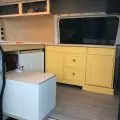Hey! This site is reader-supported and we earn commissions if you purchase products from retailers after clicking on a link from our site.
What is oxidation and why does it happen?
The process of oxidation is very similar to rust occurring on iron or most steel products over time after the have been exposed to the natural elements. If you have brass or copper items, heavy oxidation takes place in the form of patina, which over time turns those items green. However, when dealing with your fiberglass RV, oxidation is not as nearly unique or attractive as a well-aged bronze statue. In fact, it’s unsightly and takes the shine off the gelcoat layer of the fiberglass that is the outer skin of most RVs leaving a gritty residue that makes your rig look dirty and not well maintained.
How can I remove the oxidation from my RV?
Removing oxidation is a simple process of cleaning and waxing. Whenever I clean, polish and wax my 5th wheel RV, I prefer to use Meguiar’s heavy duty oxidation remover. Over the years, I have restored several vintage fiberglass boats from the late 1960’s and early 1970’s. I have also restored many vintage campers from the same era, and it has always given me great pleasure and a sense of pride when I could restore an RV or boat back to its original glory.
Meguiar’s Oxidation Remover is the best product for this process, and I would highly recommend that you choose this cleaner if you are having issues with oxidation on your RV too.
The application process is very simple as is the removal process. However, you should keep in mind that if you are working to restore a fifty year old boat or camper, its likely that it won’t be very effective in your restoration project because the protective layer of gelcoat will have become spider cracked and its colors faded over time.
If you’re working on a restoration project, it’s likely that you’ll need to reapply an outer layer of gelcoat. Before you start that process, it’s essential that any oxidation or mold be removed from the fiberglass surface of the trailer or the gelcoat application will not properly bond to the surface it’s being applied to at the time. Here is a good option from Home Depot.
When cleaning the oxidation from my RV, where do I begin?
The first thing you should do when giving your RV a thorough exterior cleaning is to start with a bucket of soap and water and good firm but soft bristled brush for buffing out the grime.
For this, I would recommend the Harper 21 inch long handle soft bristle wash brush which is always available from Home Depot.
Once you have cleaned the surfaces of your rig with soap and water, the next step is to apply your oxidation remover. For this step, it’s important that that you don’t go overboard. In other words, do this in steps. Apply the oxidation remover in small areas and then seal those areas as you progress through the project. This is especially important because it will become harder to remove the oxidation cleanser the longer it has been applied to the surface.
After I’ve cleaned the skin of my RV surface and cleared off the oxidation, how do I seal the surfaces?
To correctly clean the RV from oxidation, you’ll need to have cleaned its surfaces and you should apply a correct layer of cleanser. This will prevent surface oxidation and you should try to keep up with this as your RV ages. The next step is to polish the surfaces vigorously with a soft cloth or a brush attached to a buffer that’s intended to protect the project at hand. Once you have cleaned the surface of your rig, it’s important that you seal that surface with a good RV wax that will hold up over time.
These steps are essential to maintaining the integrity of your RV and I’m happy to share them with you. As always, my friends, thanks for following along with my columns and I hope to see on the road sometime.


